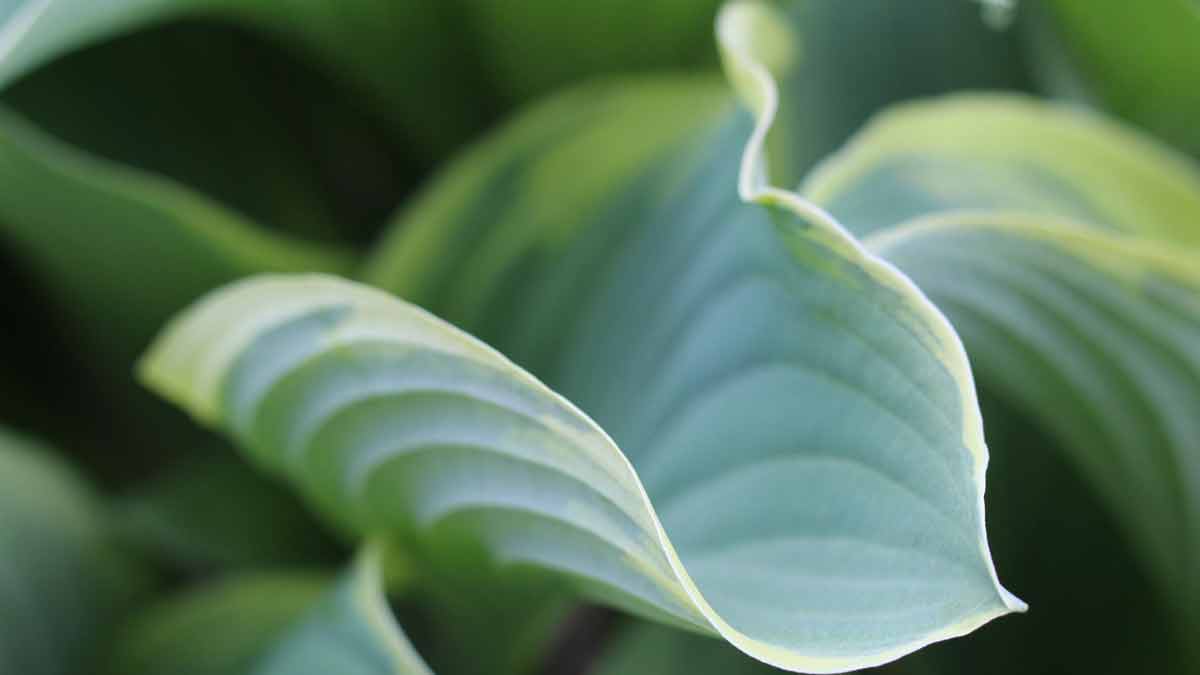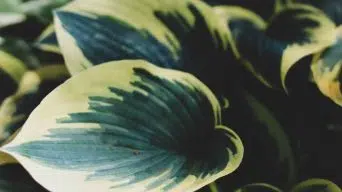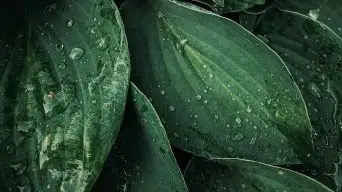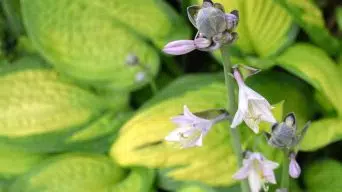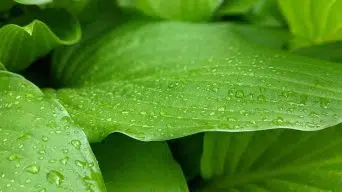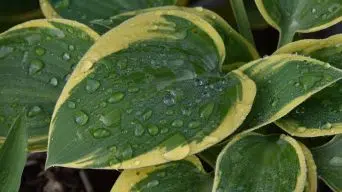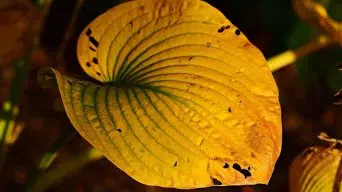Hosta plants are vigorous, fast-growing perennials that are relatively easy to care for.
They are known for their large, lush leaves and showy flowers.
However, sometimes hostas will develop problems, such as leaf curl. This can be a frustrating issue because it can cause the plant’s leaves to become distorted and discolored.
There are several reasons why hosta leaves may start to curl.
But don’t worry; it is not a severe problem and can be easily fixed in most cases.
Here you will find out why your hosta leaves are curling and what you can do about it.
Why Are My Hosta Leaves Curling and How Can You Fix It?
There are several reasons why your hosta leaves might be curling.
It’s essential to be able to identify the problem so that you can take the appropriate steps to fix it.
Here are some of the most common causes of leaf curl in hostas, as well as what you can do about them:
1. Underwatering
One of the most common reasons for leaf curling in hostas is underwatering.
Hostas are generally quite tolerant of drought and can even go without water for extended periods.
However, they will start to show signs of stress if they are not watered regularly.
Leaf curl is often one of the first signs of a plant not getting enough water.
How To Tell If Your Plant Is Underwatered
There are a few telltale signs that your plant is not getting enough water, including:
- Wilting leaves
- Dry, brown patches on the leaves
- Leaf drop
- Dry, crumbly soil
How To Treat an Underwatered Hosta
If you think your plant is not getting enough water, you first need to check the soil.
Stick your finger into the soil and see how moist it is. If the soil is dry, then your plant needs water.
Water your plant deeply, making sure to wet all of the roots.
Be sure to water your plant in the morning, so the leaves have time to dry off before nightfall.
You should also consider changing your watering schedule, so your plant gets water more frequently.
2. Overwatering
While underwatering is a common problem, overwatering hostas can cause leaf curl.
Hosta plants are native to woodlands and other areas with high moisture levels, so they don’t need as much water as many other plants.
Too much water can cause the leaves to curl and the plant to lose its vigor.
When watering your hosta, ensure the soil is moist but not soggy.
Be especially careful not to overwater in the fall, as this can make the plant more susceptible to disease over winter.
How To Tell If Your Hosta Plant Is Overwatered
There are a few signs that your plant is getting too much water, including:
- Yellow or wilting leaves
- Mushy or soft leaves
- Leaf drop
- Waterlogged soil
- Rotten roots
How To Treat an Overwatered Hosta Plant
If you think your plant is getting too much water, you first need to check the soil.
Stick your finger into the soil and see how moist it is. Your plant has too much water if the soil is soggy or waterlogged.
Let the soil dry out for a few days before watering again.
You should also consider changing your watering schedule, so your plant gets water less frequently.
You also need to check the drainage of your pot. If the pot does not have adequate drainage, the roots could be sitting in water, which can cause root rot.
3. Pests
Pests are another common reason for leaf curling in hostas.
Aphids, spider mites, and other tiny pests can cause the leaves to curl and distort.
Pests can also cause the plant to become stunted and weak.
Aphids are one of the most common pests that attack hostas. These small, soft-bodied insects suck the sap from the leaves, causing them to curl and distort.
They can also cause the plant to become stunted and weak.
Spider mites are another common pest that can attack hostas. These tiny spider-like creatures suck the sap from the leaves, causing them to turn yellow and eventually drop off.
They can also cause the plant to become stunted and weak.
How To Tell If Pests Attack Your Plant
There are a few signs that your plant is being attacked by pests, including:
- Curling leaves
- Yellowing leaves
- Leaf drop
- Stunted growth
- Webbing on the leaves or stems
- Holes in the leaves
How To Treat a Plant Attacked by Pests
If you think pests are attacking your plant, the first thing you need to do is check the leaves.
Look for tiny insects or spider-like creatures. If you see any, your plant is most likely infested with pests.
You can get rid of the pests by removing them by hand or using insecticidal soap.
To remove them by hand, wipe them off the leaves with a damp cloth or spray them off with water.
To use insecticidal soap, mix 1 tablespoon of soap with 1 quart of water and spray it on the leaves.
You may need to repeat this process several times to eliminate all the pests.
4. Too Much Light
While hostas need some light to grow, too much light can cause the leaves to curl.
Hostas that are grown in full sun often have leaves that are tightly curled and distorted.
Too much direct sunlight can also cause the hosta leaves to turn yellow or brown and eventually drop off.
Hostas need at least 4 hours of indirect sunlight per day to grow properly.
How To Tell If Your Plant Is Getting Too Much Light
There are a few signs that your plant is getting too much light, including:
- Brown or yellow leaves
- Leaves that are curled or distorted
- A general wilting of the plant
- Brown spots on the leaves
How To Treat a Plant That Is Getting Too Much Light
If you think your plant is getting too much light, you first need to move it to a shady location.
When growing hostas indoors, you should place them in an east- or west-facing window. This will give them the indirect sunlight they need without exposing them to direct sunlight, which can be harmful.
You can also use a sheer curtain to filter out some of the light if you can’t move the plant.
Outdoors, you can place the plant under a tree or shrub.
5. Too Much Fertilizer
Fertilizing your hosta is essential to help it grow, but too much fertilizer can be harmful.
An overdose of fertilizer can damage the roots and cause the leaves to curl.
It can also cause the plant to become stunted and weak.
Fertilizing your hosta too often can also be harmful. Hostas only need to be fertilized once a month during the growing season.
How To Tell If You Are Fertilizing Your Plant Too Much
There are a few signs that you are fertilizing your plant too much, including:
- Yellow leaves
- Leaves that are curled or twisted
- Stunted growth
- Weak stems
- The plant looks wilted or unhealthy
How To Treat a Plant That Has Been Over-Fertilized
If you think your plant has been overfertilized, you first need to stop fertilizing it.
Flush the soil with water to remove any excess fertilizer. To do this, water the plant deeply a few times.
You can also add some organic matter to the soil to help offset the effects of the fertilizer.
This includes things like compost, manure, or leaf mold.
6. Nutrient Deficiency
A nutrient deficiency can also cause the leaves of your hosta to curl.
This is most likely to happen if the soil lacks nutrients or the plant isn’t getting enough water.
Hostas need various nutrients to grow, including nitrogen, phosphorus, and potash.
Nitrogen is essential for the growth of the leaves.
A nitrogen deficiency will cause the leaves to turn yellow and eventually curl and die.
How To Tell If Your Plant Is Deficient in Nutrients
There are a few signs that your plant is deficient in nutrients, including:
- Yellow leaves
- Leaves that are small or stunted
- Slow growth
- The plant looks wilted or unhealthy
How To Treat a Plant That Is Deficient in Nutrients
If you think your plant is deficient in nutrients, the first thing you need to do is add some fertilizer.
Choose a fertilizer that is high in nitrogen and follow the instructions on the package.
Be careful not to overfertilize the plant, as this can be just as harmful as a nutrient deficiency.
You can also add some organic matter to the soil to help improve its nutrient content.
This includes things like compost, manure, or leaf mold.
7. Compacted Soil
Compacted soil can also cause the leaves of your hosta to curl.
This happens when the soil is too dense and doesn’t allow the roots to breathe.
The roots are then unable to take up water and nutrients, which can cause the leaves to curl and die.
How To Tell If Your Soil Is Compacted
There are a few signs that your soil is compacted, including:
- Water puddles on the surface of the soil
- Slow drainage
- The plant looks wilted or unhealthy
- The roots are growing close to the surface of the soil
How To Treat Compacted Soil
If you think your soil is compacted, the first thing you need to do is loosen it up.
You can break up the soil with a shovel or a garden fork.
Be sure to work the soil to a depth of at least 6 inches (15 cm).
Once the soil is loosened, you can add some organic matter to help improve its structure.
This includes things like compost, manure, or leaf mold.
You should also make sure that the soil is well-drained. You can add sand or pebbles to improve drainage if it isn’t.
8. Transplant Shock
Transplant shock can also cause the leaves of your hosta to curl.
This happens when the plant is moved from one location to another and doesn’t have time to adjust to its new environment.
The roots cannot take up water and nutrients, which can cause the leaves to curl and die.
How To Tell If Your Plant Is in Transplant Shock
There are a few signs that your plant is in transplant shock, including:
- The leaves are wilted or drooping
- The plant looks unhealthy
- Growth is slow or stunted
- The roots are tangled or damaged
How To Treat a Plant in Transplant Shock
If you think your plant is in transplant shock, you must give it time to recover.
Water it regularly and make sure it’s getting enough sunlight.
It may take a few weeks for the plant to adjust to its new environment, but it should eventually start to grow normally again.
9. Heat Stress
Heat stress can also cause the leaves of your hosta to curl.
This happens when the plant is exposed to too much heat and can’t cool down properly.
The leaves will turn yellow and then brown and eventually curl and die.
How To Tell If Your Plant Is Stressed by Heat
There are a few signs that your plant is stressed by heat, including:
- The leaves are wilted or drooping
- Leaf tips and edges are scorched
- The plant looks unhealthy
- Growth is slow or stunted
How To Treat a Plant That Is Stressed by Heat
If your plant is stressed by heat, move it to a cooler location.
Ensure it’s getting enough water and shade, and keep it out of direct sunlight.
You can also put a fan on low next to the plant to help it cool down.
Hosta plants thrive in shady areas, so if you can find a spot that’s out of the sun, that would be ideal.
10. Cold Temperatures
Cold temperatures can also cause the leaves of your hosta to curl.
This happens when the plant is exposed to freezing temperatures, which can damage the leaves and cause them to die.
How To Tell If Cold Temperatures Stress Your Plant
There are a few signs that cold temperatures, including: stress your plant
- The leaves turn brown or black
- The leaves curl up or droop
- The plant wilts
- The stems turn black or brown
How To Treat a Plant That Is Stressed by Cold Temperatures
If you think cold temperatures stress your plant, you need to take action to protect it.
Here are a few things you can do:
- Move the plant to a warmer location
- Wrap the plant in burlap or fabric to protect it from the cold
- Apply a layer of mulch around the base of the plant to insulate it from the cold
If you can’t save the plant from the cold, you may need to cut off the affected leaves.
Once the temperatures start warming up, the plant should grow new leaves.
How To Prevent Hosta Leaves From Curling
You can do a few things to prevent your hosta leaves from curling.
Here are some tips:
- Avoid overwatering your hosta. Water only when the soil is dry to the touch.
- Place your hosta in an area that receives partial sun or dappled shade.
- Mulch around your plant to help keep the roots cool and moist.
- Fertilize regularly with a balanced fertilizer.
- Prune away any damaged or diseased leaves as soon as you see them.
- Protect your plant from extreme temperatures, either too hot or too cold.
- Keep the area around your hosta free of weeds and debris.
- Check for pests and diseases regularly, and treat them accordingly.
- Provide adequate drainage for your plant.
- Keep an eye on your plant and observe any changes so you can address them promptly.
Following these tips can help prevent your hosta leaves from curling.
If you notice that your leaves are starting to curl, look at the possible causes and act accordingly.
Final Thoughts
Growing hosta plants is a great way to add some green to your landscape.
These tough plants are tolerant of a wide range of conditions and can even tolerate some neglect.
However, even the hardiest of hostas can succumb to problems from time to time.
One common issue that gardeners may notice is that their hosta leaves are curling.
While there can be many reasons why your hosta leaves are curling, the good news is that most of them are easily remedied.
By paying attention to your plant’s environment and giving it the care it needs, you can keep your hosta healthy and looking its best.

